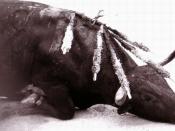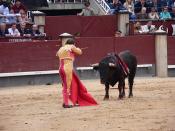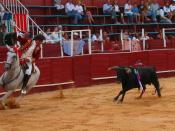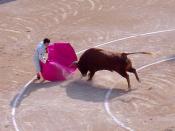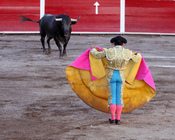BullfightingBullfighting was brought to Mexico in the early 1500's by the Spanish as they invaded, and is still a popular spectator sport there today. Bullfighting is an art form to the cultures that support it. The bullfight is set in series of events and has various players who perform at set times during the fight. It is practiced and staged just as a play or a professional wrestling match would be.. It is still very primitive and brutal as the bull is stabbed and made to suffer throughout the match. The matadors are very flamboyant, they are showmen in the strongest sense of the word. The form and style of the fight is very much the same as it was nearly five hundred years ago, although the attitudes toward bullfighting are changing "The bullfight is not a sport in the Anglo-Saxon sense, that is, it is not an equal contest or an attempt at an equal contest between bull and man.
Rather it is a tragedy".
The crowd roars as the men enter the bullring. The cheers get even louder as the bull comes through the gate to face his opponents and eventual killers. "Toreros," who are men riding on horses or on foot, first stab the bull with rainbow colored sticks called banderillas in the shoulders to wound the bull and make it tired. The "picadors" (another name for the men riding only on horseback) must know where to place the banderillas so as to provoke anger or to weaken by bleeding depending upon the strength and attitude of the bull. If a bull is not very lively or timid, the stabs will be high on the shoulders and painful to provoke him, which will give the crowd a better show. If the bull is very aggressive, the stabs will be placed deep in between the shoulder blades to cause greater bleeding, which will weaken his body.
Fighting bulls have a large mass of muscle on their necks, which is very difficult to penetrate. That muscle must be tired so the bull will hang its head low enough that the matador can reach over the horns and stab it between the shoulders with grace and style to show the crowd a good kill. A good kill will merit the matador taking either the bull's ears or tail as a sign of victory. Just killing the bull, however, does not always merit the matador taking an ear; it must be done with grace and style.
Once all the other players have exited the stage is set for the final act. The matador is the final man left in the ring with the bull and uses his muletta (cape) and sword to agitate the bull into a "dance", which consists of a series of running passes the bull makes extremely close to the matador's body (The Truth about Bullfighting). When done properly, the bull's horns will nearly brush the matador as it goes by with head low. When blood from the bull is on the matador's belly it is a sign of bravery. Once enough passes have been executed properly, the matador will go in for the kill. A sword is thrust (hopefully) between the bull's shoulder blades and should penetrate the heart killing the bull quickly. This rarely happens in real life, and a man usually has to go in after the matador and put the bull to rest with a dagger to the base of the skull. In fact, the probability of a quick death for the bull is very slim unless he gets stabbed in the lungs and drowns in his own blood. Once the bull has died and the matador has successfully entertained the crowd, the overseeing dignitary may offer him an ear or tail; however, the crowd may or may not see it the same light.
